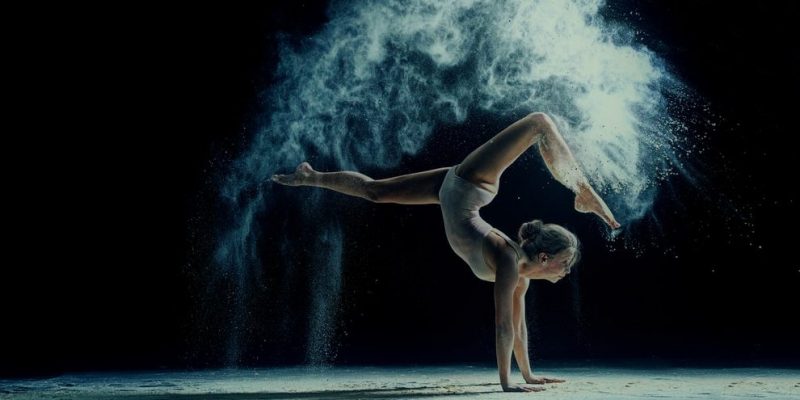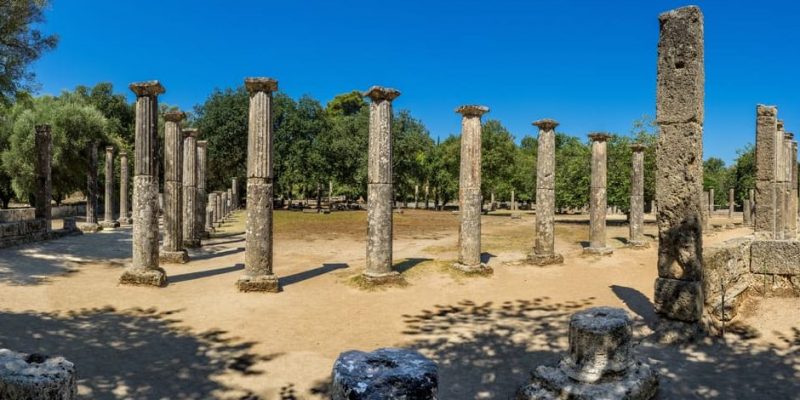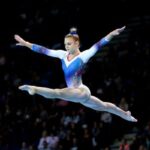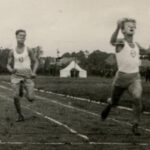We explain everything about the history of gymnastics, its development in Antiquity, the Middle Ages and Modernity to the present day.

Origin of gymnastics
Gymnastics is a activity that tests the physical capabilities of the human being through a regulated series of balance, strength, agility, flexibility and resistance exercises.
In some of its forms, gymnastics is a competitive sport. This group includes, among others, aerobic gymnastics, acrobatic gymnastics, rhythmic gymnastics, artistic gymnastics and trampoline gymnastics. These last three disciplines are also part of the Olympic Games.
The term gym comes from ancient Greek gymnós“naked”, since in Greece athletes exercised without clothes. The place where the exercises were practiced was the gym. It was precisely in ancient Greece that gymnastics was developed as a sporting discipline.
As a general physical activity, gymnastics has existed since prehistoric times: the acquisition and development of physical skill occupied a central place in survival, for which it was essential to know how to attack and defend oneself.
Later, physical exercise He diversified into different practices of swimming, wrestling, rowing, horse riding and archery. Such practices, initially carried out for military purposes, were also carried out for competitive purposes and were integrated into religious rituals.
See also: History of athletics
Gymnastics in Antiquity

Gymnastics as a sport emerged in Greece, around the 8th century BC. c. However, the practice of physical exercises in a methodical manner is much older. Several testimonies are preserved from Crete, China and Egypt in which people are shown performing various athletic activities. Some of these testimonies date back to 2000 BC. c.
For the ancient Greeks, Gymnastics was part of a set of practices aimed at promoting physical and mental health which, in turn, was framed in an ideal of human beauty. These practices were carried out in places intended for the physical preparation and training of children and young people: gyms.
Gymnastics included some activities that are currently considered separate sports, such as boxing, wrestling and athletics. The Olympic Games, established in the year 776 BC. C, they included them among their tests, along with other exercises.
Gymnastics played a central role in Greek education. In Sparta it was subordinated to combat preparation. In Athens, on the other hand, it was part of a comprehensive training, in which physical education was accompanied by the teaching of art and philosophy.
The Romans, heirs of Greek culture, adopted the Spartan conception of gymnastics, according to which it was primarily a means to achieve a military objective. Soldiers were instructed in physical preparation so that they would be more effective.
Physical training was also essential for gladiators, the center of the Roman circus shows. Otherwise, The Romans did not share the Greek idea of the educational value of gymnastics to which, in any case (and together with its military importance), they assigned a “hygienic” value, linked to health.
Gymnastics in the Middle Ages and the Renaissance
In the Middle Ages, Gymnastics lost importance due to Christianity's rejection of the cult of the body practiced in ancient Greece. However, in artistic itinerant companies, mountebanks, jugglers and volatineros continued to perform certain exercises, such as cartwheels and other acrobatic activities.
During the Renaissance, In the context of the revaluation of Greek culture that characterized the time, interest in gymnastics resurfaced. In 1569, the Italian physician and pedagogue Hieronymus Mercurialis (1530-1606) published Gymnastic artconsidered the first treatise on sports medicine, in which gymnastics is addressed in relation to the maintenance of health.
Some years later, in 1599, the Italian acrobat and tightrope walker Archange Tuccaro (1535-1602) published Dialogues about the exercise of jumping in the aira book that contains more than 80 engravings that illustrate 50 acrobatic exercises.
Gymnastics in the modern era

Modern gymnastics emerged in the 18th century with the Enlightenment. In 1762, the French philosopher Jean Jacques Rousseau (1712-1778), one of the main representatives of the Enlightenment movement, published the pedagogical treatise Emilioin which he advocated physical activity as part of teaching. The work catalyzed a profound reform in European education at the time.
The influence of Rousseau's ideas was especially important in Germany, where schools called Philanthropinumin which outdoor gymnastic activities were encouraged. From one of them emerged what is considered a precursor of modern gymnastics: Johann Christoph Friedrich Guts Muths (1759-1839), who ran one of these schools in Schnepfenthal.
Muths' thoughts are collected in his book Gymnastik für die Jugend (“Gymnastics for young people”) of 1793, in which he classified natural and artificial gymnastics, that is, utilitarian and non-utilitarian. The first focused on the health of the body, while the second focused on the aesthetic aspect of gymnastics, similar to artistic gymnastics today.
Natural gymnastics was thoroughly developed by the Swede Per Henrik Ling (1776-1839) founder of the Royal Gymnastics Central Institute in Stockholm, in 1813. But the father of modern gymnastics was the German Friedrich Ludwig Jahn (1778-1852), founder of the movement Turnvereina sort of association of gymnastics clubs in Berlin. Jahn took the first steps in the systematization of artistic gymnastics.
His advanced conception of gymnastics was recorded in the book Die Deutsche Turnkunst (“The German Art of Gymnastics”), from 1816, whose authorship he shared with his assistant Ernst Eiselen. Germany's first gymnastics festival (Turnfest) was held in Coburg in 1860 following the school of Jahn.
In 1881 the European Gymnastics Federation was founded in France predecessor of the current International Gymnastics Federation (FIG), to supervise practices in this sport, which was included in the first modern Olympics, in 1896.
The FIG organized the first international gymnastics competitions for men (1903) and women (1934); Thus consecrated gymnastics as a competitive sport with global reach.
History of gymnastics in Mexico
In Mexico, There are antecedents of gymnastics in pre-Hispanic times. Like many other ancient peoples, the cultures that inhabited the current territory of Mexico practiced physical activities for military, ritual, and recreational purposes.
Some sources testify to the gymnastics and acrobatics practices of the Aztecs. The acrobats, known as mayotuncuepanithey performed various physical skill exercises together.
Modern gymnastics was developed in Mexico by European immigrants. Some of them were immersed in pedagogical theories that promoted gymnastics as part of a comprehensive education.
In 1848, the Frenchman Jean Chadafaut Turin (Juan Turín, in Spanish), opened the first gymnasium in Mexico City. Turin, considered the introducer of modern gymnastics in the country, taught classes in some schools and incorporated gymnastics into the army, following the French military model.
The first attempts to incorporate gymnastics and other sports practices in teaching date back to 1861. However, It was not until 1888, when the Federal Law of Primary Education was passed which established the practice of gymnastics as compulsory in all schools.
In 1890, the Great Central Circle of Mexican Gymnastics was created, the first physical education association in Mexico. Some years later, In 1902, the Mexican Gymnastics Academy was founded in which teachers were trained to teach gymnastics in schools.
Mexico officially participated in Olympic competitions for the first time at the Paris Olympic Games in 1924. The previous year the Mexican Olympic Committee had been created. In 1933 the Mexican Sports Confederation and the National Council of Physical Culture were established.
These three institutions, along with the National Gymnastics Federation (currently the Mexican Gymnastics Federation), founded in 1926, were fundamental for the development and dissemination of sports and competitive gymnastics in Mexico.
Continue with: History of football
References
- “Gymnastics”, on Wikipedia.
- “Gynastica”, on Wikipedia.
- “Gymnastics”, on Britannica.
- “The History of Gymnastics, Where and How It Started,” in Curious History.
- “A History of Gymnastics, From Ancient Greece to Tokyo 2020,” in Smithsonian Magazine.
- “History of gymnastics in Mexico”, in UNEGimnasia.





